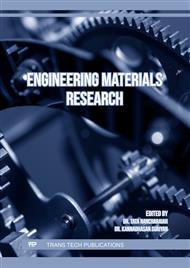p.33
p.45
p.59
p.73
p.87
p.97
p.113
p.131
p.149
Study and Investigation of Microbial Influenced Corrosion Effect for Performance Analysis of Vortex Tube on Stainless Steel with and without Coating
Abstract:
Alloy material testing for stable the properties of Vortex tube and corrosion resistance, this research for specially for fabrication of Vortex tube and also in future may supplier will ask the properties and testing evidence we are going to provide week wise testing schedule. Microbial Influenced Corrosion (MIC) is a type of corrosion that happened on a metal's surface under the seawater. MIC occurs due to the colonization of microorganism on the surface, these microorganisms may be fungus, bacteria or algae. In this paper the E. Coli bacteria are used to investigate the MIC on metal sample of vortex chamber. A metal sample of vortex tube which is stainless steel is coated with different coating such as alocit, rubber, epoxy, and graphene. The samples for vortex tube with different coating are tested to find out the best one which can resist MIC better than the others. There are different tests carried out; wet and dry test, atmospheric test. To find the corrosion progress the weight loss and corrosion rate is found in the sample material to apply vortex tube. The hardness of the coating is done to find the best one. The optical microscope is used to understand the corrosion progress in the metal surfaces and for the hardness test. The result analyzed shows that graphene is the best coating because of its excellent properties in resisting and preventing MIC corrosion of vortex tube is a non-conventional cooling device, having no moving parts which will produce cold air and hot air from the source of compressed air without effecting the environment when a high-pressure air is tangentially injected into the vortex chamber, a strong vortex flow will be created which will be split into two air streams. Beyond that, the improvement in energy separation is minor, and Vortex Tube performance begins to deteriorate as shock waves form outside the nozzle. Without any moving parts or chemical reactions, a vortex tube (VT) can generate hot and cold streams from a single pressurised room temperature fluid.
Info:
Periodical:
Pages:
87-93
Citation:
Online since:
July 2023
Authors:
Keywords:
Price:
Сopyright:
© 2023 Trans Tech Publications Ltd. All Rights Reserved
Share:
Citation:


